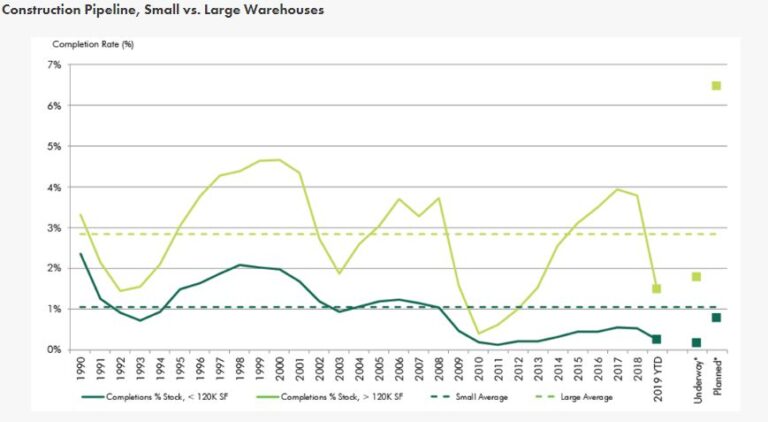Source: CBRE
Even as the growth of e-commerce has lifted the entire industrial & logistics real estate sector, a sweet spot has emerged: warehouses smaller than 120KSF, according to a new report from CBRE.
CBRE analyzed U.S. industrial buildings by size and found that “light industrial” properties outperformed the other property types over the past five years. Specifically, light industrial warehouses measuring 70KSF-120KSF registered the biggest decline in availability, down 3.9 percentage points, and the largest gain in average rents, 33.7 percent.
In metro Phoenix, light industrial properties outperformed industrial properties larger than 120KSF during the same five-year period. The vacancy rate for properties 120KSF and smaller decreased by half from 9.0 percent to 4.5 percent at the end of Q3 2019. Despite the decline in vacancy, only 16.5 percent of the industrial product under construction in Phoenix is below the 120KSF threshold. The vacancy rate for buildings above 120KSF dropped 560 basis points (bps) to 8.3 percent, which is more than 200 bps above the market-wide vacancy rate.
“With the rise of e-commerce and changing consumer expectations around delivery speeds comes the ever-growing need for users to store their inventory closer to their consumers,” said Jackie Orcutt, Senior Vice President with CBRE Industrial & Logistics. “Operating from several smaller buildings in various locations rather than from one large distribution center on one side of town allows these users to serve a greater population, faster. As a result, there is a larger pool of tenants looking for flexible, small- to mid-sized buildings. Developers are trying to keep up with this demand of this product, but because it’s more costly to build due to the scarcity and higher cost of land in infill locations and less economies of scale than building a big box facility, demand will continue to outpace supply.”
A relative dearth of construction of light industrial facilities has helped curtail availability and boost rents. Construction completions of light-industrial warehouses smaller than 120KSF have averaged one percent of the category’s overall stock since 1990, according to CBRE. In comparison, construction completions of warehouses larger than 250KSF have averaged three percent of overall stock since 1990. The shortfall for light industrial properties results mostly from high land prices in dense markets as well as competition for space from other uses, like lofts and offices.
“We’ll continue to see strong demand for light industrial facilities as e-commerce grows, which in turn means we can expect to see additional strong rent growth for these warehouses,” said Chris Zubel, a Senior Managing Director leading CBRE’s representation of Industrial & Logistics investors in the Americas. “Light industrial is the hottest coal in the campfire.”


